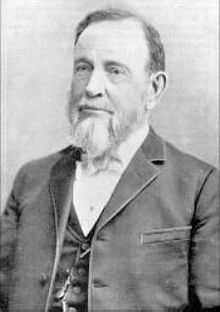Lewis A. Swift
Lewis Swift | |
|---|---|
 | |
| Born | February 29, 1820 |
| Died | January 5, 1913 (aged 92) |
| Occupation | Astronomer |
| Relatives | Edward D. Swift (son) |
| Honours |
|
| Signature | |
Lewis A. Swift (February 29, 1820 – January 5, 1913[1]) was an American astronomer who discovered 13 comets and 1,248 previously uncatalogued nebulae. Only William Herschel discovered more nebulae visually.[2]
Discoveries
Swift discovered or co-discovered a number of
He discovered his last comet at the age of 79. He was one of the few people to see
In 1878 he believed he had observed two
), but he was mistaken.Apart from comets, he also discovered hundreds of
, leading to its separate listing in the New General Catalogue as NGC 34.Life
According to Swift, he first became interested in astronomy as young boy after observing the Great Comet of 1843 while on his way to school in Clarkson, New York. His teacher initially dismissed his observation, but three days later the 'discovery' of the comet was announced.[4]
Swift conducted his early observations in
Warner went bankrupt in the Panic of 1893, which ended his financial support, and Swift then went to California to become director of Mount Lowe Observatory, taking the 16 inch telescope with him.[5]
He was married twice, first to Lucretia Hunt in 1850 and then to Carrie D. Topping in 1864. Edward D. Swift was his son by the latter wife.
Honors
Swift received an honorary Ph.D. from the University of Rochester in 1879.[4][6]
Swift received more medals than any other astronomer of his time including three made of gold from the Austrian Academy of Sciences in Vienna,[7] four made of bronze from the Astronomical Society of the Pacific, and the Laplace Medal from the Société astronomique de France (the French Astronomical Society). In 1897 he was the first person awarded the Jackson-Gwilt Medal of the Royal Astronomical Society.[4]
The
Footnotes
- ^ "Obituary Notes of Astronomers". www.astro.uni-bonn.de. Retrieved 2008-06-08.
- ISBN 978-0-387-31022-0.
- ^ NASA - Meteor Mystery, Solved? Archived 2009-04-06 at the Wayback Machine at science.nasa.gov
- ^ a b c d "Prof. Lewis Swift" (PDF). New York Times. Feb 2, 1902. Retrieved 2009-07-09.
- ^ Bibcode:1996QJRAS..37..683W.
- ^ Provost, Office of the. "Honorary Degree Recipients - University of Rochester Office of the Provost". Office of the Provost. Retrieved 2022-08-05.
- ^ "English Mechanic and World of Science, Volume 70". Google Books. 1900. Retrieved 15 May 2015.
